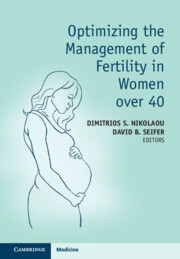Book contents
- Optimizing the Management of Fertility in Women over 40
- Optimizing the Management of Fertility in Women over 40
- Copyright page
- Dedication
- Contents
- Contributors
- Introduction
- Section 1 Demographic Trends
- Section 2 Biological Basis of Female Reproductive Aging: What Happens to the Ovaries and the Uterus as they Age?
- Section 3 Lifestyle, Environment, and Optimizing Reproduction in the 40s
- Section 4 Rethinking and Redefining “Family Planning” for the Twenty-First Century
- Section 5 Optimal Deployment of ART beyond 40
- Chapter 6 When to Use ART beyond 40: How Often, How Many Attempts, When to Stop
- Chapter 7 Optimal IVF Protocols for Women over 40 and Low Functional Ovarian Reserve
- Chapter 8 Fertility Counseling beyond 40
- Chapter 9 Support Systems and Patient Experience Architecture for Fertility Care of Women over 40 in the 2020s
- Section 6 Obstetric Management beyond 40
- Section 7 Children of Older Parents
- Section 8 What Are Realistic Alternatives to Conceiving with Autologous Eggs?
- Section 9 New Technologies
- Section 10 Ethics
- Index
- References
Chapter 8 - Fertility Counseling beyond 40
from Section 5 - Optimal Deployment of ART beyond 40
Published online by Cambridge University Press: 15 September 2022
- Optimizing the Management of Fertility in Women over 40
- Optimizing the Management of Fertility in Women over 40
- Copyright page
- Dedication
- Contents
- Contributors
- Introduction
- Section 1 Demographic Trends
- Section 2 Biological Basis of Female Reproductive Aging: What Happens to the Ovaries and the Uterus as they Age?
- Section 3 Lifestyle, Environment, and Optimizing Reproduction in the 40s
- Section 4 Rethinking and Redefining “Family Planning” for the Twenty-First Century
- Section 5 Optimal Deployment of ART beyond 40
- Chapter 6 When to Use ART beyond 40: How Often, How Many Attempts, When to Stop
- Chapter 7 Optimal IVF Protocols for Women over 40 and Low Functional Ovarian Reserve
- Chapter 8 Fertility Counseling beyond 40
- Chapter 9 Support Systems and Patient Experience Architecture for Fertility Care of Women over 40 in the 2020s
- Section 6 Obstetric Management beyond 40
- Section 7 Children of Older Parents
- Section 8 What Are Realistic Alternatives to Conceiving with Autologous Eggs?
- Section 9 New Technologies
- Section 10 Ethics
- Index
- References
Summary
Two main fertility challenges women over 40 face are decreased oocyte quality and quantity. Age is the most significant predictor of oocyte quality. There is no reliable test aimed at evaluating a single oocyte quality in vivo or in vitro following oocyte retrieval or just prior to fertilization. On the other hand, there are good ovarian reserve tests aimed at estimating the residual follicular pool in aging women: AMH, AFC, and cycle day 2-4 FSH. Each have acceptable specificity for detecting diminished ovarian reserve. The majority of clinicians prefer AMH over AFC and FSH due to its technical simplicity, lower intra- and intercycle variability and increased prognostic value in the context of older women 43,44. Once stating a desire to conceive, women who are 40 or older should have an immediate comprehensive infertility evaluation that must include prompt ovarian reserve testing. Lifestyle changes including nutrition, vitamins, exercise, stress reduction and adequate sleep can only assist in the goal. Lastly, preparation, engagement and support of a team of professionals are essential to approach conceiving over the age of 40.
Keywords
- Type
- Chapter
- Information
- Optimizing the Management of Fertility in Women over 40 , pp. 98 - 105Publisher: Cambridge University PressPrint publication year: 2022



